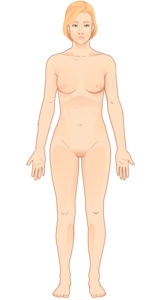Introduction
Chapter conclusion
Learning Objective
- Be able to explain and differentiate the two major branches of anatomy.
- Describe the 5 organizational level’s of anatomy.
- Navigate the body using directional references and body planes.
- Be able to properly describe body movements using anatomical terminology and be able to provide an example of each movement.
Check Your Understanding
Part A.
1. Microscopic anatomy can be described as:
a) Examines the larger structures of the body, including tissues, cells, and molecules.
b) Examines the larger structures of the body, excluding tissues, cells, and molecules.
c) Examines the smallest structures of the body, including tissues, cells, and molecules.
d) Examines the smallest structures of the body, excluding tissues, cells, and molecules.
2. ____________ is a subdivision of _________ anatomy that deals with identifying structures on the surface of the body.
a) Regional anatomy, Gross
b) Surface anatomy, Microscopic
c) Regional anatomy, Microscopic
d) Surface anatomy, Gross
3. Which of the following correctly lists the organizational levels of anatomy from smallest-largest?
a) chemical, cellular, tissue, organ, organ system
b) cellular, chemical, tissue, organ, organ system
c) chemical, cellular, organ, tissue, organ system
d) chemical, tissue, cellular, organ system, organ
4. The __________ level of anatomy is when 2 or more tissue’s work together for a specific function.
a) chemical.
b) tissue.
c) organ.
d) organ system.
5. Which of the following is a body plane used for anatomical referencing?
a) frontal plane.
b)transverse plane.
c) saggital plane.
d) all of the above.
Part B.
For the following questions, match the directional references in the word bank to the correct description. Each directional reference may be used more than once. There may be extra directional references in the word bank.
| Questions | Directional References |
 1. The head is _________ to the neck.
2. The scalp is ________ to the skull.
3. The wrist is __________ to the hand.
4. The ears are ___________ to the nose.
5. The underlying skin is ______ to the finger nail.
6. The nose is ______ to the back of the head.
7. The toes are _______ to the ankle.
8. The vertebral column is ________ to the trachea.
9. The kneecap is ______ to the knee joint.
10. The neck is ________ to the eyes.
|
a. Proximal
b. Distal c. Anterior d. Posterior e. Medial f. Lateral g. Superficial h. Deep i. Superior j. Inferior |
| Questions | Body movements |
| 1. Reducing the angle between articulating bones in the sagittal plane is?
2. Moving the arm away from midline in the frontal plane is? 3. Turning your head so that your chin is over your shoulder is? 4. Lifting your shoulders to your ears is? 5. Standing on your tip toes is? 6. Moving a body segment in a directly anterior direction is? 7. Increasing the angle between articulating bones in the sagittal plane is? 8. The combination of flexion, extension, adduction, and abduction is? 9. Positioning your hands so your palms face upwards is? 10. Dropping your jaw is? |
a. Flexion
b. Extension c. Abduction d. Adduction e. Medial rotation f. Lateral rotation g. Circumduction h. Elevation I. Depression J. Protraction K. Retraction L. Plantarflexion M. Dorsiflexion O. Pronation P. Supination |
Answer key
Part A)
1. c 2. d 3. a 4. c 5. d
Part B)
1. i 2. g 3. a 4. f 5. h 6. c 7. b 8. d 9. g 10. j
Part C)
1. a 2. c 3. f 4. h 5. l 6. j 7. b 8. g 9. p 10. i

